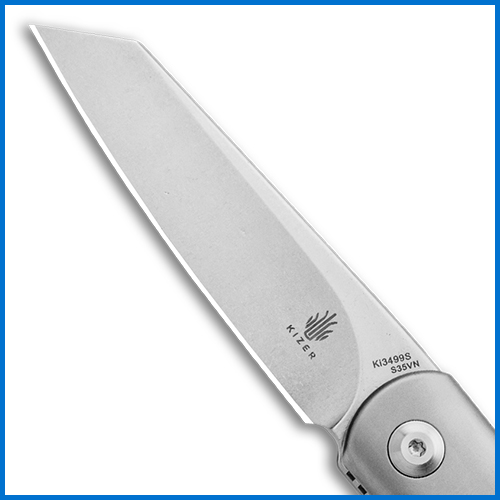You’re ready to buy your next pocket knife. You’ve been thinking about the blade steel, handle material, lock type, opening mechanism, all while making sure your knife strikes that perfect balance between badass and practical. But there’s one crucial aspect that you may be overlooking: Blade shape. The blade is the soul of the knife; it influences how the knife is best used. From a classic clip point to the unconventional hawksbill, there are many blade shapes out there to choose from and each one has its unique strengths.
In this blog post, we’ll take a deep dive into 16 of the major blade shapes, exploring their characteristics and best uses. By the end of this post, you’ll have a better understanding of how blade shape factors into a knife’s performance and be equipped with the knowledge to choose the perfect blade for your needs. So, let’s get to the point(s) and find the right blade for you.
Shop Drop Point Blade Knives
Shop Clip Point Blade Knives
Shop Spear Point Blades
4. Dagger
The dagger blade is the more aggressive sibling of the spear point blade. Dagger blades feature the same symmetry and balance as spear point blades, built for stabbing and thrusting. Characterized by two sharpened edges, dagger blades are popular among tactical knives.
Dagger knives are designed and built to be stabbing weapons, and they don’t have a lot of practical uses beyond that. As badass as they look, they don’t make the best everyday carry knives. It’s worth noting that daggers must be open carried and cannot be concealed in the state of California. Make sure you’ve checked your state’s laws before committing to a dagger shaped blade for your next pocket knife.
Shop Dagger Blade Knives
Shop Tanto Blade Knives
6. Reverse Tanto
As the name suggests, the reverse tanto blade is the mirror image of its twin brother. The reverse tanto blade features a straight spine that angles downward towards the tip. Like the tanto, the construction of the reverse tanto is reinforced with more steel — making it tougher and harder to break.
With the distinctive angle on the top of the blade instead of the belly, the reverse tanto is better at slicing than the tanto without sacrificing its strong tip and piercing ability.
Shop Reverse Tanto Blade Knives
Shop Wharncliffe Blade Knives
Shop Sheepsfoot Blade Knives
Shop Standard and Straight Back Knife Blades
Shop Hawkbill Blade Knives
12. Cleaver
Just like the coolest looking knife in your kitchen, a cleaver blade on a pocket knife excels at chopping and slicing. Built for repeated blows into dense meat and bone, cleaver blades tend to make exceptionally durable EDC options. While not a great option for piercing or stabbing, a cleaver blade is great at slicing everything from rope to food to cardboard and anything else you come across.
Shop Cleaver Blade Knives
13. Harpoon
The harpoon point blade is built much like a drop point blade, with a spine that gently slopes down into the point leaving a wide belly for slicing. The harpoon point shares all the strengths and advantages of the drop point blade, with an additional feature on the blade’s spine. Harpoon point blades are marked by an upward ramp on the spine that resembles the barbs on whaling harpoons — hence the name. The ramp provides an extra bit of leverage and control when you place your thumb on the ramp.
Shop Harpoon Blade Knives
Shop Kukri Blade Knives
15. Kriss (Reverse “S”)
The Kris knife is an asymmetrical dagger that originated in Indonesia that has traditionally served as both a weapon and a spiritual object. Kris blades are usually narrow with a wide, asymmetrical base that continues into a waving blade. As an EDC option, the wavy blade is more decorative and ceremonial than it is versatile and reliable.
Shop Kriss Point Blades
16. Gut Hook
The Gut hook Blade undoubtedly has the meanest sounding name of all the blade shapes and was built specifically for hunting and field dressing. The gut hook blade looks like a drop point with a wide belly good for slicing. The distinctive sharpened hook behind the tip of the blade is designed to open the insides of an animal without damaging the muscle. While most gut hook blades are found on fixed blade knives, you can find the occasional folding knife version.
Shop Gut Hook Blades
Blade Style Variations & Other Fun Stuff
Recurve Blades
A recurve blade is more a feature of a blade type rather than a blade type in and of itself. For example, you might call a Kukri a recurve blade because of the concave portion of the knife. At the same time, it’s common to find drop point and trailing point knives with recurves in their blades.
Modified Blades
Modified blade shapes are another popular trend in the world of knives, with many artisans and bladesmiths experimenting with variations on classic blade styles to create new and unique designs. These modified blade shapes may include alterations to the tip, edge, or spine of the blade. These variations of existing styles don’t necessarily constitute their own blade shape but can be categorized as modified versions of existing shapes.
Learn More
The video below highlights many of the different grinds and steels you can find on knives today. Different grinds can be found with different blade shapes, so keep both in mind and pick the one that suits your fancy.
Shop All Blade Shapes
Other Best Knife Guides
Still in that information gathering phase? We’ve got a bunch more guides on many different topics! Happy hunting and may you find that one special knife of your dreams.
















































